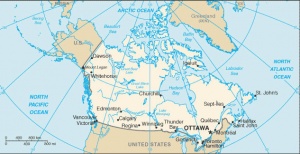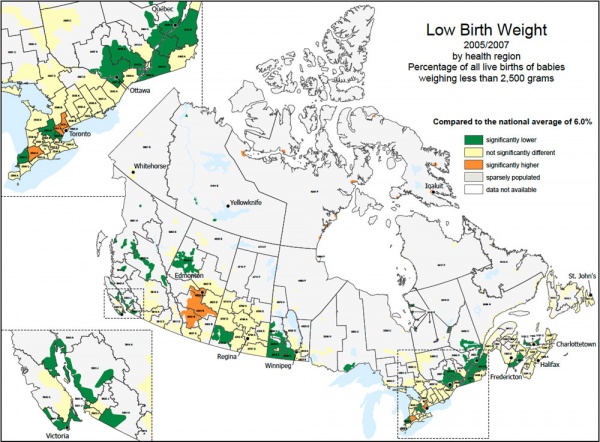Canada Statistics: Difference between revisions
mNo edit summary |
mNo edit summary |
||
| Line 11: | Line 11: | ||
Source: Health Indicator Maps, catalogue no. 82-583-XIE, Vol. 2010, No.1. (CANSIM Table 102-4303). Produced by the Geography Division for the Health Statistics Division, Statistics Canada, 2010. | Source: Health Indicator Maps, catalogue no. 82-583-XIE, Vol. 2010, No.1. (CANSIM Table 102-4303). Produced by the Geography Division for the Health Statistics Division, Statistics Canada, 2010. | ||
== Some Recent Findings == | |||
{| | |||
|-bgcolor="F5FAFF" | |||
| | |||
* '''The uses of ultrasonography in relation to foetal malformations in Rio de Janeiro, Brazil.'''<ref name=PMID23631792 ><pubmed>23631792 </pubmed></ref> "The world-wide diffusion of prenatal ultrasound has encountered local historical, cultural and political particularities. The purpose of this article is to study the varied uses of this technology in cases of detection of a foetal anomaly, in Rio de Janeiro, in a context of generalized access to ultrasound, restrictive legislation on abortion and major social inequalities. An ethnographic approach was chosen combining from 2009 to 2011, observations of prenatal consultations and interviews with specialist physicians and pregnant women, in both public and private sector institutions. Analysis of the data allowed us to identify three ideal-typical moments in the trajectory of the pregnant women when a foetal malformation was detected." | |||
|} | |||
{| class="wikitable collapsible collapsed" | |||
! More recent papers | |||
|- | |||
| [[File:Mark_Hill.jpg|90px|left]] {{Most_Recent_Refs}} | |||
Search term: [http://www.ncbi.nlm.nih.gov/pubmed/?term=Canada+Embryology+Statistics ''CanadaEmbryology Statistics''] | |||
<pubmed limit=5>Canada Embryology Statistics</pubmed> | |||
|} | |||
==Canadian Growth Charts== | ==Canadian Growth Charts== | ||
Revision as of 13:40, 4 February 2014
| Embryology - 23 Apr 2024 |
|---|
| Google Translate - select your language from the list shown below (this will open a new external page) |
|
العربية | català | 中文 | 中國傳統的 | français | Deutsche | עִברִית | हिंदी | bahasa Indonesia | italiano | 日本語 | 한국어 | မြန်မာ | Pilipino | Polskie | português | ਪੰਜਾਬੀ ਦੇ | Română | русский | Español | Swahili | Svensk | ไทย | Türkçe | اردو | ייִדיש | Tiếng Việt These external translations are automated and may not be accurate. (More? About Translations) |
Introduction
This page links to the current online resources available to explore Canadian population and birth data.
| Statistics Links: Introduction | Reports | World Population | World Fertility | World Infant Mortality | Maternal Mortality | Australia | Brazil | Canada | China | Germany | India | Indonesia | Europe | Myanmar | Netherlands | Spain | United Kingdom | Romania | Uganda | United States | BGD Tutorial - Applied Embryology and Teratology | National Perinatal Statistics Unit | AIHW | Category:Statistics | |
|
Low Birth Weight by Region
Source: Health Indicator Maps, catalogue no. 82-583-XIE, Vol. 2010, No.1. (CANSIM Table 102-4303). Produced by the Geography Division for the Health Statistics Division, Statistics Canada, 2010.
Some Recent Findings
|
| More recent papers |
|---|
|
This table allows an automated computer search of the external PubMed database using the listed "Search term" text link.
More? References | Discussion Page | Journal Searches | 2019 References | 2020 References Search term: CanadaEmbryology Statistics <pubmed limit=5>Canada Embryology Statistics</pubmed> |
Canadian Growth Charts
- New standards: WHO growth charts measure up for Canada PDF
- Promoting optimal monitoring of child growth in Canada: Using the new who growth charts PDF
General Statistics
Population: 34,030,589 (July 2011 est.) country comparison to the world: 37
Age structure
- 0-14 years: 15.7% (male 2,736,737/female 2,602,342)
- 15-64 years: 68.5% (male 11,776,611/female 11,517,972)
- 65 years and over: 15.9% (male 2,372,356/female 3,024,571) (2011 est.)
Median age
- total: 41 years
- male: 39.8 years
- female: 42.1 years (2011 est.)
Population growth rate
- 0.794% (2011 est.)
- country comparison to the world: 136
Birth rate
- 10.28 births/1,000 population (2011 est.)
- country comparison to the world: 187
Death rate
- 7.98 deaths/1,000 population (July 2011 est.)
- country comparison to the world: 105
Sex ratio
- at birth: 1.056 male(s)/female
- under 15 years: 1.05 male(s)/female
- 15-64 years: 1.02 male(s)/female
- 65 years and over: 0.78 male(s)/female
- total population: 0.98 male(s)/female (2011 est.)
Infant mortality rate
- total: 4.92 deaths/1,000 live births
- country comparison to the world: 183
- male: 5.26 deaths/1,000 live births
- female: 4.56 deaths/1,000 live births (2011 est.)
Life expectancy at birth
- total population: 81.38 years
- country comparison to the world: 12
- male: 78.81 years
- female: 84.1 years (2011 est.)
Total fertility rate
- 1.58 children born/woman (2011 est.)
- country comparison to the world: 178
Age structure
- 0-14 years: 20.1% (male 32,107,900/female 30,781,823)
- 15-64 years: 66.8% (male 104,411,352/female 104,808,064)
- 65 years and over: 13.1% (male 17,745,363/female 23,377,542) (2011 est.)
Median age
- total: 36.9 years
- male: 35.6 years
- female: 38.2 years (2011 est.)
Population growth rate
- 0.963% (2011 est.)
- country comparison to the world: 119
Birth rate
- 13.83 births/1,000 population (2011 est.)
- country comparison to the world: 149
Death rate
- 8.38 deaths/1,000 population (July 2011 est.)
- country comparison to the world: 89
Sex ratio
- at birth: 1.047 male(s)/female
- under 15 years: 1.04 male(s)/female
- 15-64 years: 1 male(s)/female
- 65 years and over: 0.75 male(s)/female
- total population: 0.97 male(s)/female (2011 est.)
Infant mortality rate
- total: 6.06 deaths/1,000 live births
- country comparison to the world: 176
- male: 6.72 deaths/1,000 live births
- female: 5.37 deaths/1,000 live births (2011 est.)
Life expectancy at birth
- total population: 78.37 years
- country comparison to the world: 50
- male: 75.92 years
- female: 80.93 years (2011 est.)
Total fertility rate
- 2.06 children born/woman (2011 est.)
- country comparison to the world: 123
HIV/AIDS
adult prevalence rate
- 0.3% (2009 est.)
- country comparison to the world: 91
people living with HIV/AIDS
- 68,000 (2009 est.)
- country comparison to the world: 50
deaths
- fewer than 1,000 (2009 est.)
- country comparison to the world: 69
Ethnic groups
British Isles origin 28%, French origin 23%, other European 15%, Amerindian 2%, other, mostly Asian, African, Arab 6%, mixed background 26%
Data: The World Factbook Canada
External Links
External Links Notice - The dynamic nature of the internet may mean that some of these listed links may no longer function. If the link no longer works search the web with the link text or name. Links to any external commercial sites are provided for information purposes only and should never be considered an endorsement. UNSW Embryology is provided as an educational resource with no clinical information or commercial affiliation.
- Statistics Canada - Pregnancy and births
- The World Factbook Canada
Glossary Links
- Glossary: A | B | C | D | E | F | G | H | I | J | K | L | M | N | O | P | Q | R | S | T | U | V | W | X | Y | Z | Numbers | Symbols | Term Link
Cite this page: Hill, M.A. (2024, April 23) Embryology Canada Statistics. Retrieved from https://embryology.med.unsw.edu.au/embryology/index.php/Canada_Statistics
- © Dr Mark Hill 2024, UNSW Embryology ISBN: 978 0 7334 2609 4 - UNSW CRICOS Provider Code No. 00098G
- ↑ <pubmed>23631792 </pubmed>


